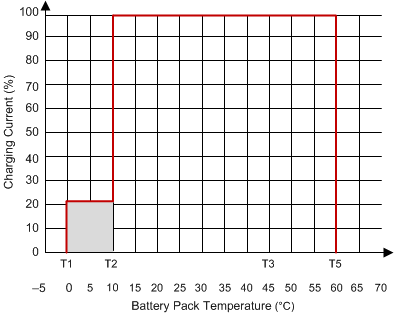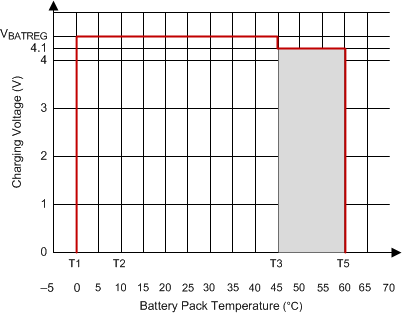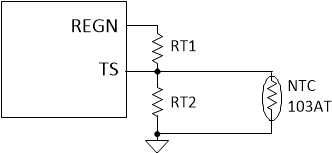ZHCSGR3C May 2017 – September 2021 BQ25606
PRODUCTION DATA
- 1 特性
- 2 应用
- 3 说明
- 4 Revision History
- 5 说明(续)
- 6 Device Comparison Table
- 7 Pin Configuration and Functions
- 8 Specifications
-
9 Detailed Description
- 9.1 Overview
- 9.2 Functional Block Diagram
- 9.3
Feature Description
- 9.3.1 Device Power Up from Battery without Input Source
- 9.3.2 Power Up from Input Source
- 9.3.3 Boost Mode Operation From Battery
- 9.3.4 Power Path Management
- 9.3.5 Battery Charging Management
- 9.3.6 Status Outputs ( PG, STAT)
- 9.3.7 Protections
- 10Application and Implementation
- 11Power Supply Recommendations
- 12Layout
- 13Device and Documentation Support
- 14Mechanical, Packaging, and Orderable Information
9.3.5.4 JEITA Guideline Compliance During Charging Mode
To improve the safety of charging Li-ion batteries, JEITA guideline was released on April 20, 2007. The guideline emphasized the importance of avoiding a high charge current and high charge voltage at certain low and high temperature ranges.
To initiate a charge cycle, the voltage on TS pin must be within the VT1 to VT5 thresholds. If TS voltage exceeds the T1-T5 range, the controller suspends charging and waits until the battery temperature is within the T1 to T5 range.
At cool temperature (T1-T2), the charge current is reduced to 20% of programmed fast charge current. At warm temperature (T3-T5), the charge voltage is reduced to 4.1 V. Charge termination is disabled for cool and warm conditions.
 Figure 9-2 JEITA Profile: Charging Current
Figure 9-2 JEITA Profile: Charging Current Figure 9-3 JEITA Profile: Charging Voltage
Figure 9-3 JEITA Profile: Charging VoltageEquation 1 through Equation 2 describe updates to the resistor bias network.
 Figure 9-4 TS Pin
Resistor Network
Figure 9-4 TS Pin
Resistor Network

Select 0°C to 60°C range for Li-ion or Li-polymer battery:
- RTHCOLD = 27.28 kΩ
- RTHHOT = 3.02 kΩ
- RT1 = 5.23 kΩ
- RT2 = 30.9 kΩ